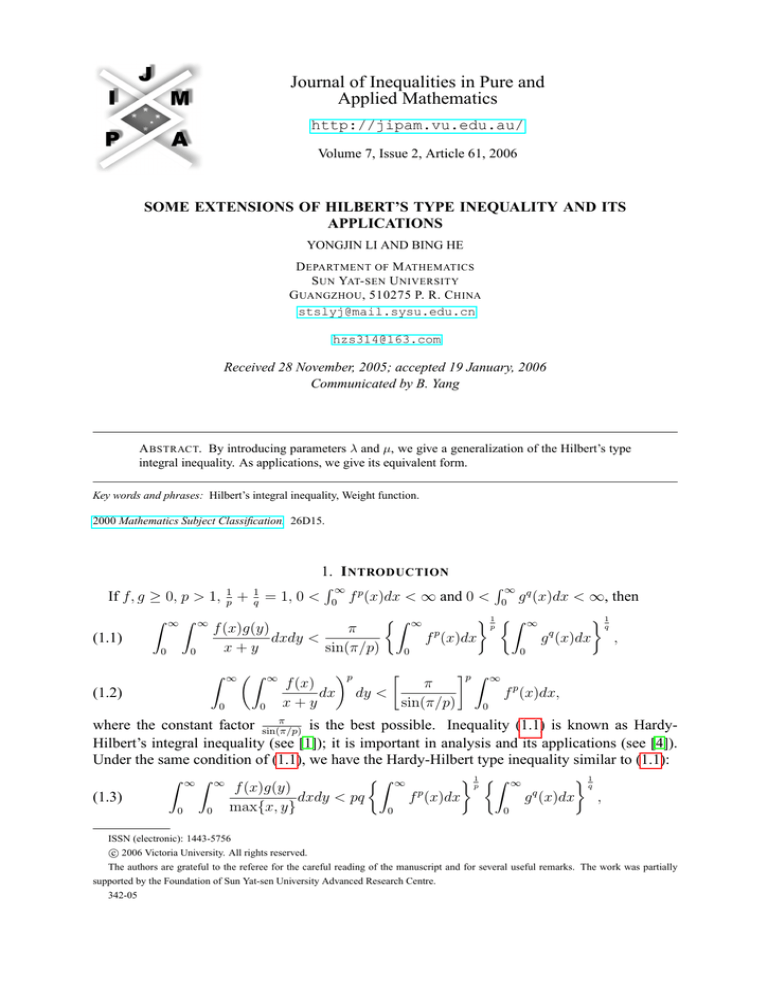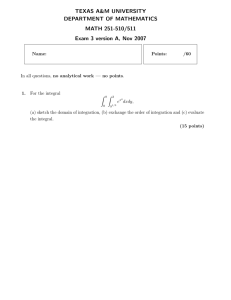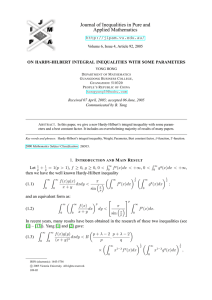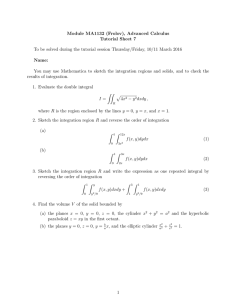
Journal of Inequalities in Pure and
Applied Mathematics
http://jipam.vu.edu.au/
Volume 7, Issue 2, Article 61, 2006
SOME EXTENSIONS OF HILBERT’S TYPE INEQUALITY AND ITS
APPLICATIONS
YONGJIN LI AND BING HE
D EPARTMENT OF M ATHEMATICS
S UN YAT- SEN U NIVERSITY
G UANGZHOU , 510275 P. R. C HINA
stslyj@mail.sysu.edu.cn
hzs314@163.com
Received 28 November, 2005; accepted 19 January, 2006
Communicated by B. Yang
A BSTRACT. By introducing parameters λ and µ, we give a generalization of the Hilbert’s type
integral inequality. As applications, we give its equivalent form.
Key words and phrases: Hilbert’s integral inequality, Weight function.
2000 Mathematics Subject Classification. 26D15.
If f, g ≥ 0, p > 1,
Z
∞
Z
(1.1)
0
0
∞
1
p
+
1. I NTRODUCTION
R∞
R∞
= 1, 0 < 0 f p (x)dx < ∞ and 0 < 0 g q (x)dx < ∞, then
1
q
f (x)g(y)
π
dxdy <
x+y
sin(π/p)
Z
∞
∞
Z
(1.2)
0
0
f (x)
dx
x+y
p
Z
p1 Z
∞
p
f (x)dx
π
dy <
sin(π/p)
q
g (x)dx
0
∞
1q
,
0
p Z
∞
f p (x)dx,
0
π
sin(π/p)
is the best possible. Inequality (1.1) is known as Hardywhere the constant factor
Hilbert’s integral inequality (see [1]); it is important in analysis and its applications (see [4]).
Under the same condition of (1.1), we have the Hardy-Hilbert type inequality similar to (1.1):
Z ∞
p1 Z ∞
1q
Z ∞Z ∞
f (x)g(y)
p
q
(1.3)
dxdy < pq
f (x)dx
g (x)dx ,
max{x, y}
0
0
0
0
ISSN (electronic): 1443-5756
c 2006 Victoria University. All rights reserved.
The authors are grateful to the referee for the careful reading of the manuscript and for several useful remarks. The work was partially
supported by the Foundation of Sun Yat-sen University Advanced Research Centre.
342-05
2
YONGJIN L I AND B ING H E
Z
∞
Z
∞
(1.4)
0
0
f (x)
dx
max{x, y}
p
p
Z
∞
f p (x)dx,
dy < (pq)
0
where the constant factor pq is the best possible. The corresponding inequality for series is:
! p1 ∞ ! 1q
∞ X
∞
∞
X
X
X
am b n
bqn
,
< pq
apn
(1.5)
max{m,
n}
n=1
n=1
n=1 m=1
where the constant factor pq is also the best possible. In particular, when p = q = 2, we have
the well-known Hilbert type inequality:
Z ∞
12 Z ∞
12
Z ∞Z ∞
f (x)g(y)
2
2
(1.6)
dxdy < 4
f (x)dx
g (x)dx .
max{x, y}
0
0
0
0
In recent years, Kuang (see [3]) gave a strengthened form as:
(∞
) p1 ( ∞
) 1q
∞ X
∞
X
X
X
am b n
<
(1.7)
[pq − G(p, n)]apn
[pq − G(q, n)]bqn
,
max{m, n}
n=1 m=1
n=1
n=1
where G(r, n) = r+1/3r−4/3
> 0 (r = p, q).
(2n+1)1/r
Yang (see [5, 8]) gave: for λ > 2 − min{p, q}
Z ∞Z ∞
pqλ
f (x)g(y)
(1.8)
dxdy <
λ
λ
max{x , y }
(p + λ − 2)(q + λ − 2)
0
0
Z ∞
p1 Z
(p−1)(2−λ)−1 p
×
x
f (x)dx
0
1q
∞
x
(q−1)(2−λ)−1 q
g (x)dx
0
and
Z
∞
∞
Z
(1.9)
0
0
f (x)g(y)
pqλ
dxdy
<
max{xλ , y λ }
(p + λ − 2)(q + λ − 2)
Z ∞
p1 Z
1−λ p
×
x f (x)dx
0
∞
x
1−λ q
g (x)dx
1q
.
0
At the same time, Yang (see [6, 7]) considered the refinement of other types of Hilbert’s inequalities.
In this paper, we give a generalization of Hilbert’s type inequality and an improvement as:
Z ∞
p1 Z ∞
1q
Z ∞Z ∞
1
1
f (xλ )g(y µ )
pq
−1 q
−1 p
µ
λ
x
f (x)dx
x
g (x)dx ,
dxdy < 1 1
max{x, y}
0
0
0
0
λp µq
where λ > 0 and µ > 0.
2. M AIN R ESULTS
Lemma 2.1. Suppose r > 1, 1s +
Z
1
= 1, λ, µ, ε > 0. Then
1
∞
x
(2.1)
1
r
µ
)−1
−ε( 1s + λr
Z
x− λ
0
J. Inequal. Pure and Appl. Math., 7(2) Art. 61, 2006
−1−µε
1
t r dtdx = O(1)
max{1, t}
(ε → o+ ).
http://jipam.vu.edu.au/
S OME E XTENSIONS OF H ILBERT ’ S T YPE I NEQUALITY
3
1
> 0 for ε ∈ (0, µn
] and
Proof. There exist n ∈ N which is large enough, such that 1 + −1−µε
r
x ≥ 1, we have
Z x− λ1
Z x− λ1
1 1+ −1−µε
−1−µε
−1−µε
1
1
r
−λ
t r dt =
t r dt =
.
−1−µε x
max{1, t}
1+ r
0
0
Since for a ≥ 1 the function g(y) =
1
1+
−1−µε
r
1
x− λ
1
yay
(y ∈ (0, ∞)) is decreasing, we find
1+ −1−µε
r
1
≤
1+
−1−1/n
r
1
x− λ
1+ −1−1/n
r
,
so
1
∞
Z
0<
x
µ
−ε( 1s + λr
)−1
1
x−1
<
1
=
1
λ
−1−µ
1
t r dtdx
max{1, t}
1 1+ −1−1/n
r
x− λ
0
∞
Z
x− λ
Z
1
1+
1
1+
−1−1/n
r
!2
−1−1/n
r
.
Hence relation (2.1) is valid. The lemma is proved.
Now we study the following inequality:
Theorem 2.2. Suppose f (x), g(x) ≥ 0, p > 1, p1 + 1q = 1, λ > 0, µ > 0 and
Z ∞
Z ∞
1
1
−1
p
0<
x λ f (x)dx < ∞, 0 <
x µ −1 g q (x)dx < ∞.
0
0
Then
Z
∞
Z
(2.2)
0
0
∞
f (xλ )g(y µ )
pq
dxdy < 1 1
max{x, y}
λp µq
where the constant factor
pq
1 1
λp µq
Z
∞
x
1
−1
λ
p
p1 Z
∞
f (x)dx
0
x
1
−1
µ
q
g (x)dx
1q
,
0
is the best possible for λ = µ.
Proof. By Hölder’s inequality, we have
Z ∞Z ∞
f (xλ )g(y µ )
dxdy
max{x, y}
0
0
i
h
ih
Z ∞ Z ∞ x λ1 −1 f (x) y µ1 −1 g(y)
11
n 1 1o
dxdy
=
λµ 0
0
max x λ , y µ
! pq1
! p1
Z ∞Z ∞
1
1
1
)p/q
−1
(1−
xλ
x λ
11
x λ f (x)
=
1
1
1
o
n
1−
1
λµ 0
1
µ
µ
p
0
y
y
µ
λ
max x , y
! pq1
! p1
1
1
1
)
−1
(1−
yµ
y µ
y µ g(y)
×
dxdy
1
1
n 1 1 o 1q
(1− λ )p/q
xλ
x
µ
λ
max x , y
J. Inequal. Pure and Appl. Math., 7(2) Art. 61, 2006
http://jipam.vu.edu.au/
4
YONGJIN L I AND B ING H E
Z Z
1
1 1 ∞ ∞ p( 1 −1)
f p (x)
x(1− λ )p/q
λ
n 1 1o
≤
x
1
λµ 0
0
y 1− µ
max x λ , y µ
Z
×
∞
0
∞
Z
1
y q( µ −1)
0
x
y
1
λ
dxdy
1
µ
1
)q/p
(1− µ
q
y
g (y)
n 1 1o
1
x1− λ
max x λ , y µ
p1
! 1q
y
1
µ
1
xλ
! p1
1q
dxdy .
Define the weight function ϕ(x), ψ(y) as
Z
∞
ϕ(x) :=
0
Z
1
(1− λ
)p/q
1
x
n 1 1o ·
1
y 1− µ
max x λ , y µ
∞
n 1 1o ·
max x λ , y µ
ψ(y) :=
0
! 1q
1
dy,
x ∈ (0, ∞),
dx,
y ∈ (0, ∞),
yµ
1
1
x
1
λ
y (1− µ )q/p
1
1
yµ
! p1
1
x1− λ
xλ
then above inequality yields
Z
0
∞
Z
0
∞
f (xλ )g(y µ )
dxdy
max{x, y}
Z ∞
p1 Z ∞
1q
1
1
11
q( µ
−1) q
p( λ
−1) p
≤
ϕ(x)x
f (x)dx
ψ(y)y
g (y)dy .
λµ 0
0
1
1
For fixed x, let y µ = x λ t, we have
ϕ(x) := µx
1
(p−1)(1− λ
)
Z
0
= µpqx
∞
1
1
t p −1 dt
max{1, t}
1
(p−1)(1− λ
)
1
= µpqx(p−1)(1− λ ) .
1
By the same token, ψ(y) = λpqy (q−1)(1− µ ) , thus
Z ∞
p1 Z ∞
1q
Z ∞Z ∞
1
1
f (xλ )g(y µ )
pq
−1
−1
p
q
µ
x λ f (x)dx
x
g (x)dx .
(2.3)
dxdy ≤ 1 1
max{x, y}
0
0
0
0
λp µq
If (2.3) takes the form of the equality, then there exist constants c and d, such that Kuang (see
[2])
! p1
! 1q
1
1
1
1
1
1
y q( µ −1) g q (y) y (1− µ )q/p y µ
xp( λ −1) f p (x) x(1− λ )p/q x λ
n 1 1o ·
=d
·
c
1
1
1
1
1
1
xλ
x1− λ
yµ
y 1− µ
max{x λ , y µ }
max x λ , y µ
a.e. on (0, ∞) × (0, ∞).
Then we have
1
1
cx λ f p (x) = dy µ g q (y)
a.e. on (0, ∞) × (0, ∞).
J. Inequal. Pure and Appl. Math., 7(2) Art. 61, 2006
http://jipam.vu.edu.au/
S OME E XTENSIONS OF H ILBERT ’ S T YPE I NEQUALITY
5
Hence we have
1
1
cx λ f p (x) = dy µ g q (y) = constant
a.e. on (0, ∞) × (0, ∞),
which contradicts the facts that
Z ∞
1
0<
x λ f p (x)dx < ∞
Z
∞
0<
and
0
1
y µ g q (x)dx < ∞.
0
Hence (2.3) takes the form of strict inequality. So we have (2.2).
−ε−1/λ
For 0 < ε < 12 , setting fε (x) = x p , for x ∈ [1, ∞); fε (x) = 0, for x ∈ (0, 1), and
−ε−1/µ
gε (y) = y q , for y ∈ [1, ∞); gε (y) = 0, for y ∈ (0, 1). Assume that the constant factor
pq
pq
1 1 in (2.2) is not the best possible, then there exists a positive number K with K <
1 1 ,
λp µq
such that (2.2) is valid by changing
Z
∞
Z
0
∞
Since
Z
∞
0
1
µ
1
to K. We have
1
λp µq
f (xλ )g(y µ )
dxdy < K
max{x, y}
0
λp µq
pq
∞
Z
x
1
−1
λ
p
p1 Z
f (x)dx
0
∞
x
1
−1
µ
g (x)dx
0
−1−εµ
1
t q dt = pq + o(1)
max{1, t}
q
1q
=
K
.
ε
(ε → 0+ ),
1
λ
setting y = x t, by (2.1), we find
Z ∞Z ∞
f (xλ )g(y µ )
dxdy
max{x, y}
0
0
h
ih
i
Z ∞ Z ∞ x λ1 −1 f (x) y µ1 −1 g(y)
11
n 1 1o
=
dxdy
λµ 0
0
max x λ , y µ
11
=
λµ
Z
∞
1
Z
Z
∞
1
∞
Z
∞
1
x( λ −1)+
−ε− 1
λ
p
1
y ( µ −1)+
n 1 1o
max x λ , y µ
1
(λ
−1)+
−ε− 1
λ
p
µ
µ
λ
1
−ε− µ
q
dxdy
1
(µ
−1)+
1
−ε− µ
q
µ
11
x
(t x )
n
o
x λ µtµ−1 dxdt
1
1
1
λµ 1
x− λ
max x λ , tx λ
Z ∞
Z ∞
µ
−1−εµ
1
1
1
=
x−ε( p + λq )−1
t q dtdx
1
−
λ 1
λ max{1, t}
x
Z ∞
Z x− λ1
Z ∞
µ
−1−εµ
−1−εµ
1
1
1
1
=
x−ε( p + λq )−1
t q dtdx −
t q dtdx
λ 1
max{1, t}
max{1, t}
0
0
"
#
1
pq
=
µ + o(1) .
λε p1 + λq
=
Since for ε > 0 small enough, we have
#
"
1
pq
µ + o(1) < K.
λ p1 + λq
J. Inequal. Pure and Appl. Math., 7(2) Art. 61, 2006
http://jipam.vu.edu.au/
6
YONGJIN L I AND B ING H E
1
1
It is obvious that λ p µ q ≤
λ
p
+ µq (i.e.
1
λ
1
µ
1
+ λq
p
1
≤
1
1
λp µq
) by Young’s inequality. Consider the case
1
of taking the form of the equality for Young’s inequality, we get µ q = λ
"
#
pq
pq
1
1
1 + o(1) < K.
µ + o(1) =
1
λ p + λq
λp µq
Thus we get
pq
1
1
λp µq
p−1
p
, i.e. λ = µ, Then
≤ K, which contradicts the hypothesis. Hence the constant factor
pq
1
1
λp µq
(2.2) is best possible for λ = µ.
in
Remark 2.3. For λ = µ, inequality (2.2) becomes
Z ∞
p1 Z ∞
1q
Z ∞Z ∞
1
1
f (xλ )g(y λ )
pq
(2.4)
dxdy <
x λ −1 f p (x)dx
x λ −1 g q (x)dx ,
max{x, y}
λ
0
0
0
0
where the constant factor
pq
λ
is the best possible.
R∞ 1
Theorem 2.4. Suppose f ≥ 0, p > 1, λ > 0 and 0 < 0 x λ −1 f p (x)dx < ∞. Then
p
Z ∞ Z ∞
Z ∞
1
f (xλ )
1
p
(2.5)
dx dy < (pq)
x λ −1 f (x)p dx,
max{x, y}
λ
0
0
0
where the constant factor λ1 (pq)p is the best possible. Inequality (2.5) is equivalent to (2.4).
Proof. Setting g(y) as
Z
0
∞
x
1
−1
λ
p−1
f (x)
n 1 1 o dx
max x λ , y λ
> 0,
y ∈ (0, ∞).
then by (2.4), we find
p
Z ∞
Z ∞ Z ∞
1
f (xλ )
−2
−1 q
p−1
λ
dx dy
λ
y
g (y)dy = λ
max{x, y}
0
0
0
Z ∞Z ∞
f (xλ )g(y λ )
dxdy
=
max{x, y}
0
0
1q
p1 Z ∞
Z ∞
1
1
pq
−1
q
−1
p
(2.6)
y λ g (y)dy .
≤
x λ f (x)dx
λ
0
0
Hence we obtain
Z ∞
Z ∞
1
1
−1 q
p
p
λ
(2.7)
0<
y
g (y)dy ≤ λ (pq)
x λ −1 f p (x)dx < ∞.
0
0
By (2.4), both (2.6) and (2.7) take the form of strict inequality, so we have (2.5).
On the other hand, suppose that (2.5) is valid. By Hölder’s inequality, we find
Z ∞Z ∞
f (xλ )g(y λ )
dxdy
max{x, y}
0
0
Z ∞ Z ∞
f (xλ )
=
dx g(y λ )dy
max{x,
y}
0
0
Z ∞ Z ∞
p p1 Z ∞
1q
f (xλ )
q λ
(2.8)
dx dy
g (y )dy .
≤
max{x, y}
0
0
0
J. Inequal. Pure and Appl. Math., 7(2) Art. 61, 2006
http://jipam.vu.edu.au/
S OME E XTENSIONS OF H ILBERT ’ S T YPE I NEQUALITY
7
Then by (2.5), we have (2.4). Thus (2.4) and (2.5) are equivalent.
If the constant λ1 (pq)p in (2.5) is not the best possible, by (2.8), we may get a contradiction
that the constant factor in (2.4) is not the best possible. Thus we complete the proof of the
theorem.
Remark 2.5.
(i) For λ = µ = 1, (2.2) and (2.5) reduce respectively to (1.3) and (1.4). It follows that
(2.2) is a new extension of (1.6) and (1.3) with some parameters and the equivalent form
(2.4) is a new extension of (1.4).
(ii) It is amazing that (2.4) and (1.9) are different, although both of them are the extensions
of (1.6) with (p, q)−parameter and the best constant factor.
R EFERENCES
[1] G.H. HARDY, J.E. LITTLEWOOD
bridge, 1952.
AND
G. POLYA, Inequalities, Cambridge Univ Press Cam-
[2] J. KUANG, Applied Inequalities (Chinese), Hunan Jiaoyu Chubanshe, Changsha, 1993.
[3] J. KUANG AND L. DEBNATH, On new generalizations of Hilbert’s inequality and their applications, J. Math. Anal. Appl., 245(1) (2000), 248–265.
[4] D.S. MITRINOVIĆ, J.E. PEČARIĆ AND A.M. FINK, Inequalities Involving Functions and their Integrals and Derivatives, Mathematics and its Applications, 53. Kluwer Academic Publishers Group,
Dordrecht, 1991.
[5] B. YANG, Generalization of a Hilbert type inequality and its applications (Chinese), Gongcheng
Shuxue Xuebao, 21(5) (2004), 821–824.
[6] B. YANG, On a Hilbert’s type inequality and its applications, Math. Appl. (Wuhan), 15(1) (2002),
52–56.
[7] B. YANG, A new Hardy-Hilbert type inequality and its applications (Chinese), Acta Math.
Sinica, 46(6) (2003), 1079–1086.
[8] B. YANG, Best generalization of a Hilbert-type inequality (Chinese), J. Jilin Univ. Sci., 42(1) (2004),
30–34.
J. Inequal. Pure and Appl. Math., 7(2) Art. 61, 2006
http://jipam.vu.edu.au/









